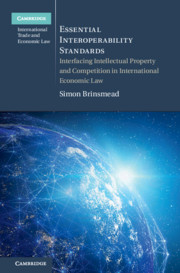 Essential Interoperability Standards
Essential Interoperability Standards Book contents
- Essential Interoperability Standards
- Cambridge International Trade and Economic Law
- Essential Interoperability Standards
- Copyright page
- Dedication
- Contents
- Foreword
- Preface
- Abbreviations
- Part I Foundations and Problems
- 1 Introduction
- 2 Standards and Interoperability Standards
- 3 Interoperability Standards and International Economic Law
- Part II The Impact of Intellectual Property and Competition Laws
- Part III Towards Liability and Compensation
- Bibliography
- Index
1 - Introduction
from Part I - Foundations and Problems
Published online by Cambridge University Press: 26 October 2021
- Essential Interoperability Standards
- Cambridge International Trade and Economic Law
- Essential Interoperability Standards
- Copyright page
- Dedication
- Contents
- Foreword
- Preface
- Abbreviations
- Part I Foundations and Problems
- 1 Introduction
- 2 Standards and Interoperability Standards
- 3 Interoperability Standards and International Economic Law
- Part II The Impact of Intellectual Property and Competition Laws
- Part III Towards Liability and Compensation
- Bibliography
- Index
Summary
The introduction explains the concerns existing in relation to access to interoperability standards and standards-essential intellectual property. The thesis is then explained and an expert-led international instrument is proposed to address the concerns identified. The topical methodology is introduced and explained. Rather than proceeding in rigidly Cartesian fashion, the work instead outlines relevant topoi or topics, such as protection under intellectual property and competition law, as well as comparison of leading jurisdictions and law and economic analysis. The parallels between the topical jurisprudence and methodologies pursued in the law of equity, notably within the common law tradition as well as in international law are noted. A brief summary of each chapter is provided.
Keywords
Information
- Type
- Chapter
- Information
- Essential Interoperability StandardsInterfacing Intellectual Property and Competition in International Economic Law, pp. 3 - 15Publisher: Cambridge University PressPrint publication year: 2021